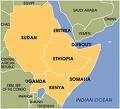Ethiopia: Amnesty International’s Report: Sensationalism Gone Wild

Amnesty International made waves this week with its report alleging ”patterns of human rights violations” on the Oromos – a community to which the President of Ethiopia belongs.
The London-based rights group claimed:
“at least 5,000 Oromos have been arrested based on their actual or suspected peaceful opposition to the government” and presented troubling accounts of individuals who allegedly had been subjected ”to treatment amounting to torture and other cruel, inhuman or degrading treatment.”
Inadequacy of the human rights practices in Ethiopia is not a much disputed matter. Even the authorities in Addis Ababa felt the need to launched an inter-ministerial National Human Rights Action Plan (NHRAP) so as to “review the present human rights situation of the country, identifies potential problems, and sets feasible solutions.”
But the similarity ends there. What the NHRAP acknowledges is “occasional human rights violations are committed by some police officers due to lack of awareness,” while Amnesty International alleges “patterns of human rights violations” in which “a multiplicity of both regional and federal actors are involved.”
While NHRAP aims:
“to develop a comprehensive and structured mechanism to advance the respect, protection and fulfillment of human and democratic rights”; western rights-groups want “the establishment of an independent commission of inquiry, fact – finding mission or comparable procedure, comprised of independent international experts.”
For a cautious observer, the essential lies in the western rights-groups’ demand and Addis Ababa’s refusal of a “confession” and an international intervention. Demands that Addis Ababa deems paternalistic, while Amnesty decries ”the repeated failure to acknowledge the existence of torture demonstrates a concerning lack of political will.”
Thus, in an apparent bid to pressure Ethiopia and her developmental partners, Amnesty picked a sensational title on the reports. With an alarmist title ”Because I Am Oromo: Sweeping Repression In The Oromia Region Of Ethiopia”, Amnesty International’s report led to sensational headlines:Ethiopia ‘targets’ Oromo ethnic group (BBC); Ethiopia ‘ruthlessly targeting’ and torturing Oromo people, says Amnesty (The Guardian); Ethiopia Systematically Repressing Oromo (VOA ) and others.
The media outlets were not entirely unjustified, as that is what the report appears to have been aiming for. Though buried in the report, a disclaimer-styled note reads:
“many of the human rights violations documented in this report…affected other ethnic groups as well as Oromo s over the same time period. However, this reports focuses specifically on Oromia and Oromo s due to the large scale of the targeting of actual or perceived dissent in the region. This research did not, however, compare the treatment of the Oromo to treatment of other ethnic groups, so the report does not seek to establish discriminatory treatment, but to specifically document patterns of violations in Oromia.”
Yet, the report consisted several contentions impressing up on the reader that the government targeted the Oromos – a community to which the President, the Dep. Prime Minister and the Hose Speaker as well as a third of the population belongs.
Two illustrations suffice: In its introductory note, it shouts ”Oromos make up a high proportion of the prison population in federal prisons …. [the numerical size of the group] alone does not account for the high proportion of Oromos in the country’s prisons”
Nonetheless, the report indicates elsewhere that ”a large proportion of former detainees interviewed by Amnesty International” were detained in region”. Though two remarks were quoted in the report to corroborate the claim, both are about decade-old and made in a political campaign gathering context – not to Amnesty’s interviewers. In fact, since the number of inmates at Federal prisons was about 18,000 – or a fifth – of the total prison population , any plausible estimate of disproportionate incarceration would not change the math by significant margin. Taking into consideration that prison density in Oromia region was 87:100,000 in 2010, while the national average was 108.
Perhaps even more bewildering is the report’s claim that ”the government has exhibited hostility to displays of Oromo cultural heritage” adding that ”participating in societies to discuss and promote Oromo culture and history also causes harassment and in some cases, arrest”. Quite to the contrary, the recent debate was on the regional government’s insistence that business owners should give the Oromo language prominence on their roadside billboards.
But there is a giveaway. Describing an arrest made during a celebration of the traditional festival of Irreecha , the report indicates ”Reported reasons for arrests included wearing clothes in colours considered as symbols of Oromo resistance – red and green – or alleged chanting of political slogans during the festival”.
The “symbols of Oromo resistance” was an euphemism the report writers chose to use for the flag/symbols of OLF (Oromo Liberation Front) – a group with a troubling track-record and recently proscribed as terrorist by Ethiopian parliament. Whether a ban on wearing flag/symbols a terrorist group is advised was an issue on which Amnesty could have cast light on.
This is not a rebuttal of the report, as that requires further analyses. Again, as noted earlier, the rights group may be tempted to use sensational headings and catchy-phrases which may be excusable approach if a single-minded focus on saving others is presumed.
Yet, employing hyperbolic statements that stir emotions in an entire community does a disservice to the primary objective of the report and leads the conversation astray.
Daniel Berhane is an Ethiopian resident, lawyer by training and editor and blogger at HornAffairs.com
Source: globalresearch.ca

No comments:
Post a Comment